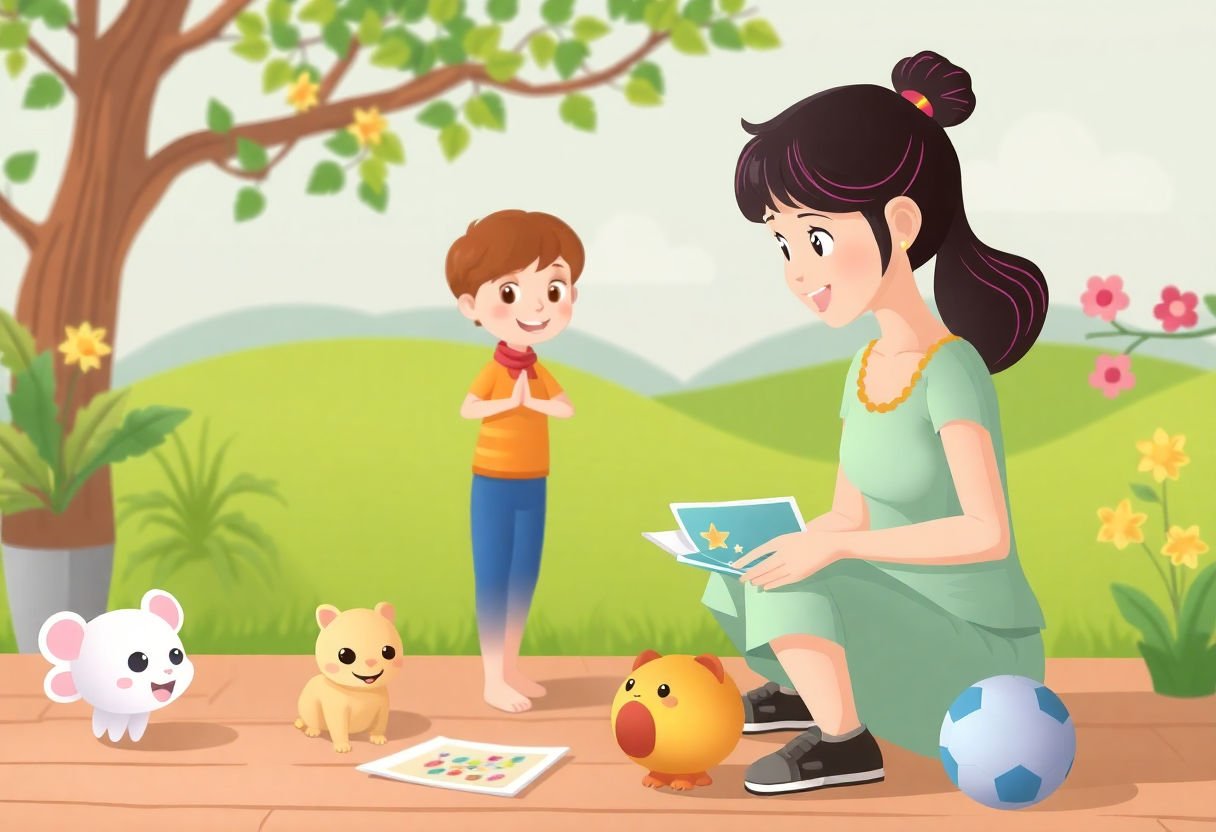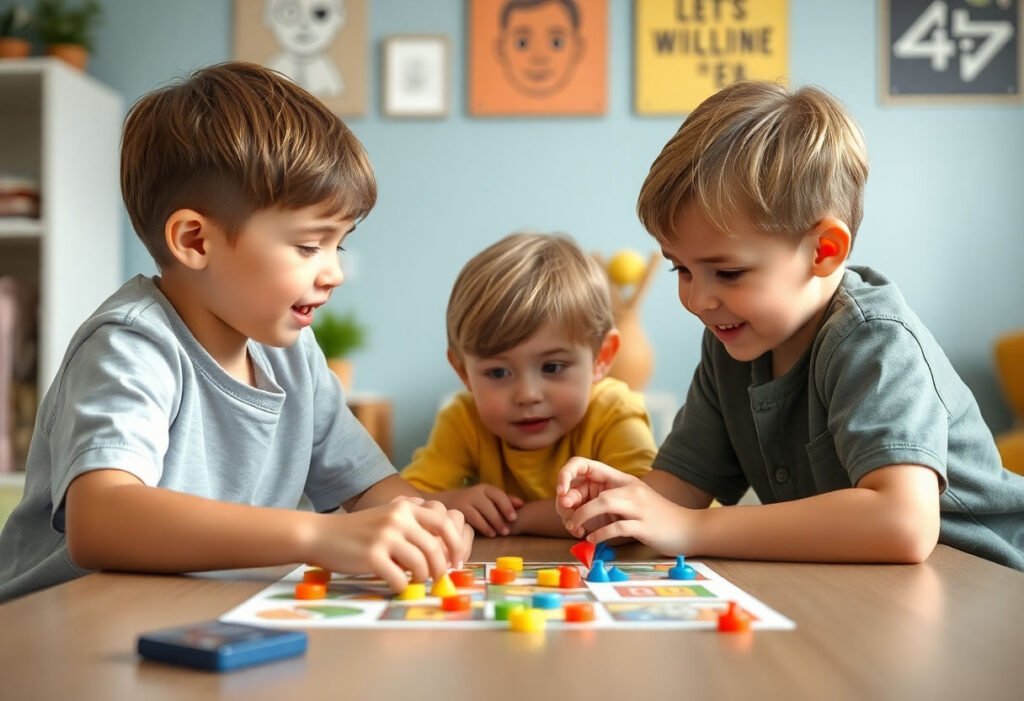Understanding and managing emotions is a fundamental part of a child’s development, shaping their ability to interact with the world. This article delves into the engaging world of games that help teach emotional regulation to children. Through well-structured play, children learn to recognize and express their emotions in a healthy manner. We will explore the significance of emotional regulation, how games serve as an educational tool, and the crucial role adults play in guiding this learning process. Join us as we uncover playful pathways to foster emotional growth and stability, promoting a healthier developmental journey for children.
Key Takeaways
- Games provide a structured yet flexible medium for teaching emotional regulation to children, making learning both engaging and effective.
- Through play, children can learn to recognize and express their emotions, which fosters a healthy development of emotional intelligence.
- The involvement of adults is crucial, as their guidance ensures that children are gleaning the maximum benefits from these games.
- Emotional learning games can be seamlessly incorporated into daily routines, enhancing their impact on children’s growth.
- Regular observation and adjustment can help track children’s progress in emotional growth, facilitating continued improvement and learning.
The Importance of Emotional Regulation in Childhood

Emotional regulation is a cornerstone of a child’s development, impacting their ability to interact constructively with others and handle stress effectively. Mastering emotional regulation allows children to identify, express, and manage their emotions, which is crucial for mental health and well-being.
During the formative years, children experience rapid emotional development. It’s imperative that they learn to regulate their emotions to build healthy relationships and succeed in educational settings. Studies show that children who possess strong emotional regulation skills tend to perform better academically and develop stronger social connections.
There are several key reasons why emotional regulation is vital during childhood:
- Enhanced social skills: Children who manage emotions are more adept at forming and maintaining friendships.
- Improved academic performance: Emotional regulation is linked to focus, resilience, and adaptability in learning environments.
- Better conflict resolution abilities: Children can navigate disagreements more peacefully and effectually with emotional awareness.
In addition, emotional health in childhood sets the foundation for a balanced adulthood. When children learn to regulate their emotions, they are equipped to face life’s challenges with integrity and resilience. Emotionally balanced children are less likely to engage in risky behaviors and more likely to develop into well-adjusted adults.
Nurturing emotional regulation from a young age is essential in shaping a child’s future. Through interactive tools and positive reinforcement, children can learn to navigate their emotions, fostering a harmonious balance between feelings and actions.
How Games Facilitate Learning
Games serve as a powerful tool for learning, seamlessly blending enjoyment with education, especially in the context of emotional regulation. By offering an interactive environment, games allow children to experiment and explore emotions in a safe and controlled setting. Through role-play and storytelling, children are able to identify and exhibit various emotions, which fosters a deeper understanding of their own feelings and those of others.
Moreover, the structured nature of games provides clear guidelines and objectives, teaching children the importance of following rules and self-control. For instance, games that require turn-taking help develop patience and enhance social interactions—a crucial component of effective emotional regulation.
Some games simulate real-life social situations, enabling children to practice empathy and problem-solving skills. By navigating through challenges and receiving immediate feedback, children are encouraged to reflect on their actions and the emotions they evoke, which leads to better emotional insight.
Furthermore, games often incorporate rewards and achievement systems, motivating children to persist and manage frustration. This is particularly beneficial in helping them understand the delayed gratification concept, which is a fundamental aspect of emotional growth.
In essence, games facilitate learning by engaging children in activities that resonate with their experiences, offering meaningful lessons about emotional awareness and self-regulation in a fun and captivating way. This innovative approach not only enhances emotional learning but also promotes lifelong skills essential for personal and social success.
Top Games for Teaching Emotional Regulation

Emotion Charades
Emotion Charades is a dynamic game that encourages children to express and guess emotions through body language and facial expressions. This interactive game helps children learn how to identify and articulate different emotions, improving their understanding and communication skills. By acting out emotions like happiness, sadness, anger, and surprise, children gain a deeper insight into how emotions look and feel.
Feelings Bingo
Feelings Bingo introduces children to a broad spectrum of emotions, enhancing their emotional vocabulary. Each player receives a bingo card filled with various emotional words and scenarios. As emotion-related prompts are called out, children must match them to the words on their cards. This game not only broadens children’s awareness of emotions but also fosters empathy by placing them in different emotional contexts.
Mood Cards
Mood Cards are a versatile tool for teaching emotional regulation, presenting a series of cards each depicting different emotions through pictures or words. Children select cards that reflect their current emotions or scenarios that might cause such feelings. This game encourages introspection and helps children learn to connect their emotions with specific contexts, leading to better self-understanding and management.
Inside Out: Emotional Rollercoaster
Inspired by the popular animated movie “Inside Out,” this board game allows children to explore emotions through the characters Joy, Sadness, Anger, Fear, and Disgust. Players navigate various scenarios that evoke different emotions, promoting discussion about emotional responses and ways to manage them effectively. The game emphasizes recognizing emotional triggers and developing strategies for coping with them in real-life situations.
These games, infused with creativity and engagement, provide invaluable support for children in mastering emotional regulation, setting a foundation for healthier interactions and emotional health.
Role of Adults in Guiding Emotional Learning Through Games
Adults play a pivotal role in facilitating and enhancing children’s emotional learning through games. By engaging consciously in this process, parents and educators can create an environment where emotional skills are not only taught but also consistently practiced and reinforced.
Modeling Emotional Responses
One effective strategy is for adults to model appropriate emotional responses. By demonstrating how to navigate emotions in various scenarios—such as dealing with frustration when losing a game—they provide a tangible example for children to emulate. This modeling helps children understand that all emotions are natural and manageable.
Engagement and Participation
Adults should actively participate in these games, as their involvement lends legitimacy to the activity and keeps children motivated. Their presence reassures children that it’s safe to express their emotions, fostering a supportive atmosphere where open discussions about feelings are encouraged.
Providing Guidance and Feedback
Offering constructive feedback during and after games is crucial. Adults can guide children in labeling their emotions, helping them articulate precisely what they are feeling. Moreover, providing positive reinforcement when a child employs appropriate emotional regulation techniques can significantly boost their confidence and willingness to apply these skills outside the gaming context.
Creating a Safe Space
Finally, adults must ensure the gaming environment is a safe space, free from judgment. This involves setting clear boundaries for acceptable behavior and encouraging empathy and understanding among all participants. Such an environment helps children feel secure enough to express their emotions and learn from their experiences without fear of retribution or ridicule.
Integrating Emotional Learning into Daily Activities
Incorporating emotional learning into daily activities can significantly bolster a child’s ability to manage emotions, ultimately fostering better interpersonal skills and mental well-being. Here are some strategies to seamlessly integrate emotional learning into everyday routines:
Begin by embedding simple emotion recognition exercises in daily conversations. Engage children by asking them how they felt during specific incidents throughout the day, such as when playing with friends or during mealtime. Encourage them to use a range of emotions, like happy, surprised, frustrated, or content. This consistent practice helps broaden their emotional vocabulary and fluency.
Consider designing short, interactive role-playing activities, which can be immensely powerful. For instance, during a family dinner, take turns role-playing different emotions or scenarios and discussing the various feelings each situation might evoke. Role-play fosters empathy and allows children to explore different emotional responses in a safe environment.
Storytime can also be a golden opportunity to discuss emotions. When reading books or watching shows together, pause to discuss how characters might be feeling and why. This habit nurtures critical thinking and helps children correlate actions with emotional outcomes.
Transforming routine tasks into engaging emotional learning games is another effective technique. Turn chores into an opportunity for learning by associating them with certain emotions or creating a challenge where a child expresses a specific emotion while completing tasks. These practices make emotional learning fun and unobtrusive.
Finally, model emotional regulation by demonstrating your own emotional processing aloud. Expressing your feelings and explaining how you handle them offers children a tangible template to emulate, guiding them towards healthier emotional management. By weaving these practices into daily life, emotional learning becomes an integral, seamless part of a child’s development.
Observing Emotional Growth in Children

Monitoring the emotional growth of children engaged in emotional regulation games can reveal remarkable progress in their ability to understand and manage emotions. As children participate in these activities, caregivers can note several indicators of emotional maturity.
Firstly, increased emotional awareness is a hallmark of growth. Children start to identify and label their emotions more accurately, moving beyond basic feelings of happiness or sadness to more complex emotions such as frustration or empathy. This newfound ability is crucial as it forms the foundation for effective emotional communication.
Moreover, as children become more emotionally aware, they often exhibit enhanced emotional vocabulary. They begin incorporating more intricate terms to express their feelings, a key component in articulating emotions clearly and reducing misunderstandings in social interactions.
Observing children during gameplay, adults may also notice improved impulse control. Children who previously acted out impulsively may pause to assess their responses, demonstrating a growing ability to manage their reactions. This adjustment is vital for building resilience and patience, fostering a more harmonious interaction with their peers.
Furthermore, participation in emotional regulation games often leads to better problem-solving abilities. As children learn to handle their emotions, they are more inclined to approach challenges with a calm mindset, facilitating more thoughtful decision-making processes.
Careful observation and encouragement by adults during these games are imperative. Providing positive reinforcement when children demonstrate progress helps reinforce their learning and self-confidence, promoting a continuous journey of emotional development.
Addressing Challenges in Emotional Learning
In the journey of emotional learning, children may encounter several challenges that require careful navigation. Recognizing and addressing these obstacles is essential for fostering a supportive learning environment.
One common challenge is emotional misunderstanding, where children may misinterpret or fail to understand their emotions fully. This can lead to frustration and impede emotional expression. To address this, adults should engage in open conversations, providing children with vocabulary to articulate their feelings. Incorporating storytelling or role-playing can also help children visualize and understand different emotions.
Another significant challenge is emotional overwhelm. Children may feel inundated by intense emotions, making regulation difficult. Introducing breathing exercises or mindfulness activities during games can help children manage these overwhelming feelings. Encouraging breaks and allowing time for processing can also ease emotional burdens.
Moreover, resistance to emotional vulnerability may occur when children are hesitant to express their feelings due to fear of judgment or misunderstanding. Creating a safe and accepting environment is crucial. Adults should model vulnerability by sharing their emotions and demonstrating that it is normal to experience a wide range of feelings. This openness encourages children to do the same without fear of negative consequences.
Lastly, consistency in emotional learning can be an obstacle. Regular practice through games scheduled into daily routines ensures steady progress. Establishing a routine helps normalize emotional learning, making it an integral part of a child’s day rather than a sporadic activity.
By proactively addressing these challenges, adults can significantly enhance the effectiveness of emotional learning games, ensuring that children benefit fully from these enriching experiences.
Conclusion
In summary, integrating fun games into children’s lives is a powerful strategy for enhancing emotional regulation. These activities not only facilitate emotional recognition and expression but also strengthen the bonds between children and adults who guide them. As emotional skills develop, children become better equipped to navigate complex social environments. Moving forward, consistent adult involvement is crucial to maximize these gains. Encouraging regular engagement in emotional learning games is an investment in a child’s future emotional resilience and well-being. With dedication and patience, adults can unlock a child’s full emotional potential through playful learning experiences.
Frequently Asked Questions
How do emotional regulation games benefit children?
Emotional regulation games provide children with a safe and engaging environment to explore and understand their emotions. They help develop skills for identifying and managing feelings, which are crucial for emotional intelligence.
At what age should children start with emotional learning games?
Children can begin exploring emotional learning games as early as preschool. Starting early helps in cultivating emotional awareness and self-regulation from a young age, setting the foundation for healthy emotional growth.
Can these games replace traditional teaching methods?
While these games are powerful tools, they are most effective when used in conjunction with traditional teaching methods. Integrating games with other approaches ensures a well-rounded development of emotional skills.
How much time should be allocated to these games daily?
Allocating about 20-30 minutes daily for emotional regulation games can be effective. It cultivates a routine while allowing children ample time to engage and learn without overwhelming them.
What if a child shows no interest in these games?
It is essential to introduce games that are appealing to the child’s interests. Encouraging participation without force can eventually spark interest, and observing which types of games the child gravitates toward can guide future choices.


